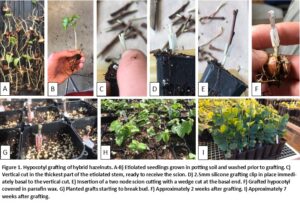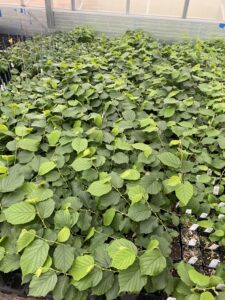Progress report for FNC24-1408
Project Information
Dane Hauser is co-owner and manager of Hauser’s Superior View Farm in Bayfield, WI. He is the region’s largest producer of containerized hazelnut seedlings. He also works closely with the University of Wisconsin and University of Minnesota in developing vegetative propagation protocols for hazelnuts with a focus on softwood stem cuttings, seed-graft layering, and stool-bed layering. He recently collaborated with Upper Midwest Hazelnut Development Initiative (UMHDI) researchers on a proof-of-concept project demonstrating that seed-graft layering can turn a single dormant bud into up to three field-ready rooted layers within two years. For this project, Dane will be responsible for growing the seed-grafted plants from mid-April 2024 through November 2024. He will also grow the successfully grafted plants in a high tunnel greenhouse and mound-layer the new shoots in 2025.
Midwest Hazelnuts, LLC (MH) is a spin-off business from the UMHDI tasked with shepherding the early commercialization stages of the Midwest hazelnut industry through targeted business enterprises including propagation and sale of improved germplasm, operation of an open-access processing facility, and establishment and management of a network of hazelnut Go-First Farms. MH works closely with nurseries and producers to scale-up propagation and nursery stock production including production of stock plants for the nurseries to use in their downstream propagation efforts. MH is the exclusive seller of UMHDI 1st Generation Selections and will work closely with Hausers in this seed grafting project.
Expanding hazelnut production in the Upper Midwest will
require greatly increasing the supply of the newly released UMHDI
1st Generation Selections. There are currently orders
for more than 40,000 plants and the TNC's EAP is likely to expand
that to 400k plants. Although nurseries are working to increase
supply through tissue culture and stem cuttings, it is important
that enterprising growers can produce their own plants using
relatively inexpensive propagation methods. This enables growers
to participate in the nursery industry and provide some income
while they wait for their own plants to mature and bear
nuts.
Unfortunately, hazelnuts are very difficult to propagate
vegetatively. They aren’t like currants or elderberry where you
can stick a hardwood stem in the ground and it grows. So far, the
nurseries haven’t had much success with softwood stem cuttings or
tissue culture, either. Instead, everyone has been relying
on the effective (but slow) mound-layering technique. The UMHDI
researchers have been successful recently with a relatively
low-tech method called seed-graft layering, but it has only been
done on a small proof-of-concept scale by Hausers. We propose to
test the method at scale and evaluate its effectiveness on all
the recently released UMHDI cultivars.
Agroforestry practices offer considerable benefits to
the land including providing habitat, holding soil in place, and
filtering water. Hazelnuts are viewed as a cornerstone species
for alley-cropping as they can provide a high-value crop AND all
the benefits of woody perennials.
The new cultivars from the UMHDI offer a great
opportunity and it is important that
enterprising farmers have the option and means necessary to make
their own plants. In cooperation with the UMHDI researchers, we
have been working on a low-tech seed-grafting method that is
capable of turning a 1-bud scion into three rooted layers in 2
years. It’s not a great multiplication rate, but it is better
than the traditional mound-layering system that can take 3-5
years to produce new plants. In year 1, we graft the bud on a
newly sprouted seed and grow the grafted plant in a greenhouse
all year. After over-wintering the plant, we cut it back to just
a few buds and plant it in a high tunnel greenhouse, where growth
rates are superior to outside the high tunnel. The plants
grow for roughly two months and produce 2-5 new shoots.
Around mid-June we layer those shoots in sawdust to produce
roots. By the end of October, we have field ready plants. A
diagram showing the process from the proof of concept trial is
attached.
Though the method has worked in small-scale
proof-of-concept trials, we now need to try it at scale on all
the UMHDI cultivars. This will allow us to determine with which
cultivars it works and to produce enterprise budgets to determine
costs of production.
Objective 1: Optimize the protocol for growing
seed-grafted plants in a greenhouse in year 1.
Objective 2: Evaluate the effectiveness of the high
tunnel layering system on the UMHDI hazelnut cultivars.
Objective 3: Record all cost inputs and rooted-layer
outputs to develop an enterprise budget for the system.
Objective 4: Share the results and enterprise budget at
the annual Upper Midwest Hazelnut Growers Conference in March
2025.
Cooperators
- - Producer
- - Producer
Research
Seed-Grafting Methods
Seeds from hybrid hazelnut plants were harvested in early September 2023, stored in cool moist conditions until de-husked in early October. Immediately after de-husking, the seeds were soaked in water for 12 hours, and then stored in a ventilated plastic storage tub at 39 F until late February 2024. Seeds were soaked in water for 12 hours approximately once per month during the stratification period.
To produce etiolated shoots with adequate thickness for grafting, seeds were placed in black plastic trays to exclude light and retain high humidity, placed in a 75 F mist house, and watered daily. Once radicles appeared, four to six germinated seeds were planted at a depth of 12 cm (4.7 in) into AB36 Anderson Bands with Sun-Gro 852 Professional potting mix and watered thoroughly. The planted seeds were then grown in a 75 F greenhouse. Once the shoots emerged from the soil (2-4 weeks), the seedlings were rinsed of potting soil, stored in plastic trays and grafted within 6 hours of harvest.
Scion wood from hybrid hazelnut genotypes were harvested in early November 2023 from the apical 20 cm of 7-month old coppice shoots produced by coppicing the source plant in April. The stems were then stored in unventilated contractor trash bags at 39 F for 14 days. The bags were then transferred to a freezer and stored at 28 F until used for grafting in the spring. Five days prior to each grafting date, the scions were transferred to a 39 F cooler. On the day of grafting, individual scionwood stems were cut into 1-2 node sections with the basal end cut into a wedge.
To graft, scion pieces were removed from black plastic trays and allowed to air dry until free surface water had evaporated. Rootstocks were selected in an attempt to match the diameter of the scion wedges, but often the scions were moderately thicker than the rootstock shoots they were grafted to. The rootstock shoots were cut at the thickest, straightest portion of the stem of adequate length for grafting, remaining stem length averaged 1-2 in. The shoot was split in half with a scalpel to a depth equal to the length of the wedge of the scion, a 2.5mm silicone vegetable grafting clip was attached to the base of the shoot to prevent the shoot from splitting further when inserting the scion, the scion was inserted into the cleft, and the clip moved upwards along the stem to secure the graft union. The grafted plant was then inverted and dipped quickly (less than 1 second) into an approximately 50/50 (v/v) mix of paraffin and cheese wax and immediately placed into a bin of cool water for 15-60 minutes to cool and harden the wax and avoid heat injury to graft union.
Grafted plants were potted into Proptek 28 pots (28 Cell 10×20″ Pot-In-Frame Tree Propagation System, Blackmore Co.) with a 50/50 (v/v) mixture of Pro Mix BRK and Sun Gro 852 Professional potting mixes with 4.7g/L of Osmocote Plus (15-9-12) slow-release fertilizer incorporated into the medium prior to planting. Grafted plants were then grown a greenhouse set at 77 F / 72 F daytime/nighttime temperature under halogen lamps set to 16 hr days for subsequent graft healing and growth. Grafts were watered and rootstock sucker shoots were removed as needed. Successful grafts broke bud 10-21d after grafting, and were fertigated weekly with Jack's Professional 20-3-19 Petunia FeED Plus Mg at 400 ppm N. Graft success was assessed 7 weeks after grafting; grafts with >12.7 cm (5 in) shoot growth, a healthy terminal growing tip, and healthy leaves were deemed successful. The mean grafting success for each treatment rep was calculated by dividing the total number of successful grafts by the total number of grafts. To calculate a treatment mean, the grafting success was averaged across the replications for each treatment.
Stool bed layering in the high tunnel will occur in 2025.
3449 grafts were made in the spring of 2024 from February 24 through April 12. Specific grafting dates and number of grafts made on each grafting date depended on germination of seeds and growth of the hypocotyl shoots. Of the 3449 grafts made, 1812 grew vigorous shoots from the scion for an average success rate of 52%, though some genotypes had rates as high as 61% as shown in the table below. Our goal was 500 successful grafts per each of 4 genotypes, but the numbers generated are adequate to run the stool-bed layering trial in the high tunnel in 2025. We also tried different concentrations of IAA applied to the graft union but there was no difference across the concentrations.
| Grafting Success by Genotype | |||
| Genotype | # of grafts made | # of successful grafts | % successful |
| 10-18 | 85 | 46 | 54% |
| 13-16 | 80 | 48 | 60% |
| 8-66 | 37 | 17 | 46% |
| 9-12 | 52 | 22 | 42% |
| 9-67 | 40 | 22 | 55% |
| Arb7-1 | 730 | 250 | 34% |
| NBlais | 611 | 374 | 61% |
| PriceW41 | 771 | 451 | 58% |
| StapN7-6 | 1043 | 582 | 56% |
| Total | 3449 | 1812 |
52%
|
Educational & Outreach Activities
Participation summary:
Hauser's hosted a tour with the UMHDI research team in August 2024 to see the grafting project.
We are almost done with a journal article and will submit it to the Journal of Environmental Horticulture in February. The article will report on the grafting and a pilot study done on layering the grafted plants done outside the scope of this project. The pilot study is being used to inform methodology for the layering to be done for this project in 2025.
We are planning to present the seed grafting work at the UMHDI hazelnut growers conference March 7-8, 2025.
Learning Outcomes
We have shown that hypocotyl-grafting with hazelnuts is viable with a success rate averaging 52% across genotype and grafting date. It is a very space efficient method as it doesn't require large rootstock plants. Our pilot project evaluating layering the scion stems in the year after grafting can produce 3-4 rooted layers, so we are excited to apply the lessons learned from the pilot project to the 2025 layering trials with the grafts we made in 2024. Put together, this method of hypocotyl seed-graft layering should be able to produce 3-4 rooted layers in two years, which is better than rooting a 4-5 node tip cutting or epicotyl grafting onto larger rootstock.
Project Outcomes
Additional work needs to be done with hypocotyl grafting to improve graft healing and scion growth rates. Things to explore include scion-seed compatibility, temperature and moisture during the graft healing process, use of auxins to speed graft healing, maturity and location from the mother plant of the 1-2 node scion stems.

